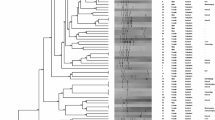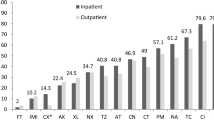Abstract
Escherichia coli is the common causative agent of urinary tract infections. Sixty-one strains ofE. coli isolated from children with urinary tract infections were tested by colony hybridization for the presence of genes determining P and S fimbriae and hemolysin. Of these strains, 46 possess a gene for hemolysin, 44 for P fimbriae and 28 for S fimbriae. Only 30 strains formed lytic zones around the colonies on plates with sheep erythrocytes. The results indicated that simultaneous occurrence of genes in urinaryE. coli was highest for P fimbriae and hemolysin and lower for other combinations of the tested genes.
Similar content being viewed by others
References
Evans D.T., Evans D.G., Höhne C., Noble M.H., Haldane E.V., Lior H., Young L.S.: Hemolysin and K-antigens in relation to serotype and hemagglutination type ofEscherichia coli isolated from extraintestinal infections.J. Clin. Microbiol. 13, 171–178 (1981).
Finlay B.B., Falkow S.: Common themes in microbial pathogenicity.Microbiol. Rev. 53, 210–230 (1989).
Green C.P., Thomas V.L.: Hemagglutination of human type O erythrocytes, hemolysin production, and serogrouping ofEscherichia coli isolates from patients with acute pyelonephritis, cystitis, and asymptomatic bacteruria.Infect. Immun. 31, 309–315 (1981).
Hacker J., Knapp S., Goebel W.: Spontaneous deletions and flanking regions of the chromosomally inherited hemolysin determinant of anEscherichia coli 06 strain.J. Bacteriol. 154, 1145–1152 (1983).
Hacker J., Ott M., Schmidt G., Hull R., Goebel W.: Molecular cloning of the F8 fimbrial antigen fromEscherichia coli.FEMS Microbiol. Lett. 36, 139–144 (1986).
Jusková E., Čižnár I.: Application of biotinylated and 32P probes for detection of P-fimbriae in urinaryE. coli.Folia Microbiol. 38, 259–263 (1993).
Maniatis T., Fritsch E.F., Sambrook J.:Molecular Cloning, a Laboratory Manual. Cold Spring Harbor Lab, New York 1982.
Nicaud J.M., Mackman N., Gray L., Holland I.B.: Characterization of HlyC and mechanism of activation and secretion of haemolysin fromE. coli 2001.FEBS Lett. 187, 339–344 (1985).
Normark S., Lark D., Hull R., Norgren M., Baga M., O'Hanley P., Schoolnik G., Falkow S.: Genetics of digalactosidase-binding adhesin from a uropathogenicEscherichia coli strain.Infect. Immun. 41, 942–949 (1983).
Ott M., Hacker J., Schmoll T., Jarchau T., Korhonen T.K., Goebel W.: Analysis of the genetic determinants coding for the S-fimbrial adhesin (sfa) in differentEscherichia coli strains causing meningitis or urinary tract infections.Infect. Immun. 54, 646–653 (1986).
Ott M., Schmoll T., Goebel W., Van Die I., Hacker J.: Comparison of the genetic determinant coding for the S-fimbrial adhesin (sfa) ofEscherichia coli to other chromosomally encoded fimbrial determinants.Infect. Immun. 55, 1940–1943 (1987).
Pawelzik M., Heesemann J., Hacker J., Opferkuch W.: Cloning and characterization of a new type of fimbria (S/F1C-related fimbria) expressed by anEscherichia coli 075:K1:H7 blood culture isolate.Infect. Immun. 56, 2918–2924 (1988).
Schönian G., Sokolowska-Köhler W., Bollmann R., Schubert A., Gräser Y., Presber W.: Determination of S fimbriae amongEscherichia coli strains from extraintestinal infections by colony hybridization and dot enzyme immunoassay.Zbl. Bakt. 276, 273–279 (1992).
Svanborg-Eden C., Hanson H.A.:Escherichia coli pili as possible mediators of attachment of human urinary tract epithelial cells.Infect. Immun. 21, 229–237 (1978).
Van den Bosch J.F., Postma P., de Graaff J., MacLaren D.M.: Haemolysis by urinaryEscherichia coli and virulence in mice.J. Med. Microbiol. 14, 321–331 (1981).
Welch R.A., Dellinger E.P., Minshew B., Falkow S.: Haemolysin contributes to virulence of extraintestinalE. coli infections.Nature (London) 294, 665–667 (1981).
Westerlund B., van Die I., Kramer C., Kuusela P., Holthöfer H., Tarkkanen A.M., Virkola R., Riegman N., Bergmans H., Hoekstra W., Korhonen T.K.: Multifunctional nature of P fimbriae of uropathogenicEscherichia coli: Mutations infsoE andfsoF influence fimbrial binding to renal tubuli and immobilized fibronectin.Mol. Microbiol. 5, 2965–2975 (1991).
Wold A.E., Caugant D.A., Lidin-Janson G., de Man P., Svanborg C.: Resident colinicEscherichia coli strains frequently display uropathogenic characteristics.J. Inf. Dis. 165, 46–52 (1992).
Author information
Authors and Affiliations
Rights and permissions
About this article
Cite this article
Jusková, E., Čižnár, I. Occurrence of genes for P and S fimbriae and hemolysin in urinaryEscherichia coli . Folia Microbiol 39, 159–161 (1994). https://doi.org/10.1007/BF02906814
Received:
Revised:
Issue Date:
DOI: https://doi.org/10.1007/BF02906814




